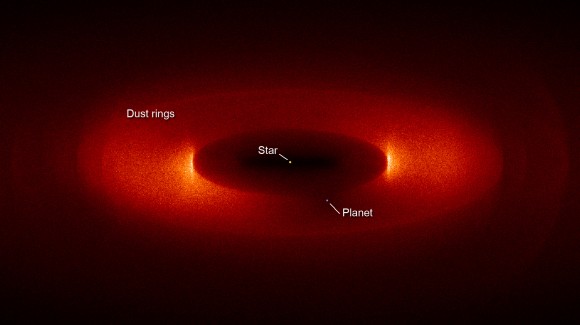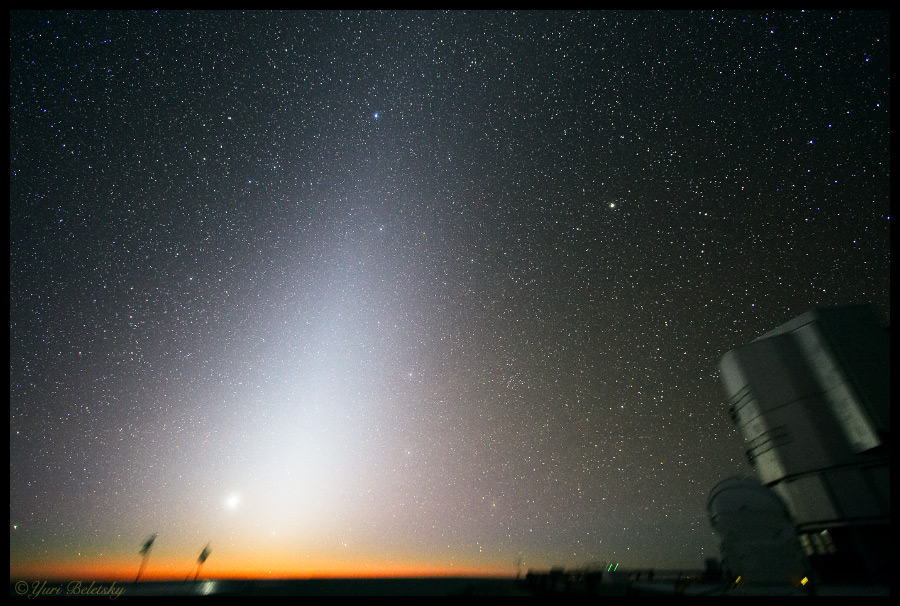[/caption]
The current exoplanet count — the number of planets astronomers have found orbiting other stars –stands at 312. That’s a lot of planets. But not a single one of them can be classified as Earth-like. We just don’t have the ability to detect planets that small yet. But it might help if we knew exactly where to look. New research using supercomputer simulations of dusty disks around sun-like stars show that planets nearly as small as Mars can create patterns in the dust that future telescopes may be able to detect. The research points to a new avenue in the search for habitable planets. “It may be a while before we can directly image earth-like planets around other stars but, before then, we’ll be able to detect the ornate and beautiful rings they carve in interplanetary dust,” says Christopher Stark, the study’s lead researcher at the University of Maryland, College Park.
Working with Marc Kuchner at NASA’s Goddard Space Flight Center in Greenbelt, Md., Stark modeled how 25,000 dust particles responded to the presence of a single planet — ranging from the mass of Mars to five times Earth’s — orbiting a sun-like star. Using NASA’s Thunderhead supercomputer at Goddard, the scientists ran 120 different simulations that varied the size of the dust particles and the planet’s mass and orbital distance.
“Our models use ten times as many particles as previous simulations. This allows us to study the contrast and shapes of ring structures,” Kuchner adds. From this data, the researchers mapped the density, brightness, and heat signature resulting from each set of parameters.
“It isn’t widely appreciated that planetary systems — including our own — contain lots of dust,” Stark adds. “We’re going to put that dust to work for us.”
Much of the dust in our solar system forms inward of Jupiter’s orbit, as comets crumble near the sun and asteroids of all sizes collide. The dust reflects sunlight and sometimes can be seen as a wedge-shaped sky glow — called the zodiacal light — before sunrise or after sunset.

The computer models account for the dust’s response to gravity and other forces, including the star’s light. Starlight exerts a slight drag on small particles that makes them lose orbital energy and drift closer to the star.
“The particles spiral inward and then become temporarily trapped in resonances with the planet,” Kuchner explains. A resonance occurs whenever a particle’s orbital period is a small-number ratio — such as two-thirds or five-sixths — of the planet’s.
For example, if a dust particle makes three orbits around its star every time the planet completes one, the particle repeatedly will feel an extra gravitational tug at the same point in its orbit. For a time, this extra nudge can offset the drag force from starlight and the dust can settle into subtle ring-like structures.
“The particles spiral in toward the star, get trapped in one resonance, fall out of it, spiral in some more, become trapped in another resonance, and so on,” Kuchner says. Accounting for the complex interplay of forces on tens of thousands of particles required the mathematical horsepower of a supercomputer.
Some scientists note that the presence of large amounts of dust could present an obstacle to directly imaging earthlike planets. Future space missions — such as NASA’s James Webb Space Telescope, now under construction and scheduled for launch in 2013, and the proposed Terrestrial Planet Finder — will study nearby stars with dusty disks. The models created by Stark and Kuchner give astronomers a preview of dust structures that signal the presence of otherwise hidden worlds.
“Our catalog will help others infer a planet’s mass and orbital distance, as well as the dominant particle sizes in the rings,” Stark says.
Stark and Kuchner published their results in the October 10 issue of The Astrophysical Journal. Stark has made his atlas of exo-zodiacal dust simulations available online.
Source: Goddard Space Flight Center


Hey Bill,
Check out: http://planetquest.jpl.nasa.gov/ – NASA says they’ve got proof of 312 exoplanets, Nancy links to that page.
As for Nessie, I saw some ripples in that loch once, and something eyeballed me from the depths. Admittedly I was only 8 years old with an active imagination, but that was proof enough for me
Exoplanets: 312
Loch Ness Monster: 1 (because 8-year old Ian says so)
312 planets? please show me proof of just one. that is all I ask. I am astounded that you can make such a claim without proof. It’s like saying you saw the Loc Ness monster and all you saw was a couple of waves in the water. I want to believe you guys are right, but I’m having a really hard time with what you call proof. pure speculation that is all you have. I think you should make a retraction in your statements until you prove what you say is there.
Exoplanets are found by watching a planet cause it’s parent star to wobble around slightly due to gravitational pull. The other method is finding exoplanets when they occult the light from their parent star.
These are proven scientific methods for finding exoplanets. No lock ness monster there.
you know, there may be many reasons for a star to wobble, density, heavy elements,who really knows.but you say that these “planets” can be seen when they pass in front of the parent star, SHOW me!!!!!! t ruly I want to believe your claims, all I ask for is some serious proof.
Bill-
Click on the number 312 in the article, which will take you to the Planet Quest Website. They have lots of information there which might be of interest to you.
Nancy
Bill the Troll-
All right, there are 312 sets of observations of phenomena that are consistent with the predicted effects of extra-solar planets on various measurable attributes of nearby stars. None of these observations involve “seeing” the star consistent with your stated desires for proof because direct observation is a bit beyond the capabilities of our current instrumentation. But you’d better get ready to move your goalposts. Given adequate funding and a long life, your criteria will be met in your lifetime. Plan now for the next level of “proof” you will demand.
Looked at Stark’s sims and wondered if it correctly predicts the distribution of dust in the asteroid belts. This would give some validation of his work.
A simplistic model like this might help analyze protoplanetary disks. As the planets come together, its likely one will be biggest and first. We can look for exemplars in the disks we know about. Our theories say that planets must form unless light pressure blows the disk away too quickly. That “bow wake” effect should let us see them almost as they form. Astronomy is great.
hmmm, you say 312 planets? Maybe more..
and a planet as Hearth, maybe the one next of plutão, the one who isnt at Sun system anymore..
I will check about the planet I mean, and i will post here when I´m done
see you
……. What? Science is great, but without the ability to communicate, it’s useless. Hearth?…
312 * confirmed so far * – more found but as yet unconfirmed.
And several have had direct images taken of them. Google “image of extrasolar planet.”
I suspect Bill is some sort of religious zealot who is somehow threatened by planets outside our solar system because he believes we’re special and God created just us.
Face it bill – there are many planets outside our solar system. This is a fact accepted by EVERYONE.